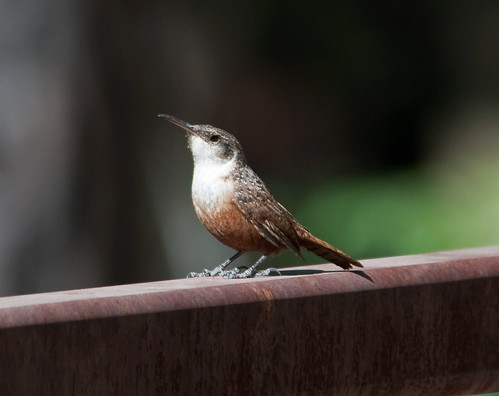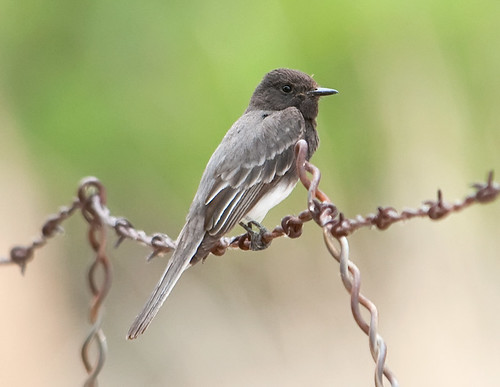Arizona Trip – Day 4
For our fourth day, we decided to reverse our previous days’ path, except we still wanted to start the morning at the South Fork. We had heard that many people were hearing the Elegant Trogon* right near the bridge, so we started there. Initially, things were a little slow as the sun was just starting to peek into the canyon, but they quickly picked up as all of the birds started to wake up, producing a magical post-dawn chorus. Numerous Empidonax flycatchers were joined by warblers and orioles in song, while other, quieter birds like the Painted Redstart and several hummingbirds flew about in frantic activity. Vireos and a few warblers (including a few Townsend’s and Wilson’s) were flitting about in the tall sycamores by the creek, while Acorn Woodpeckers competed with Canyon Wrens for top song of the morning. Soon, it was almost impossible to keep up with all of the movement and chittering on the trees.
But all of that became moot when the ‘injured dog’ call of a male Elegant Trogon came from the forest a short distance away from us. I quickly started tracking the call, triangulating to narrow the search. I tried to walk quietly, but with the drought, the density of dried leaves made it very tough. I walked in the creek bed where I could until I had to head back into the brush to find this target bird.
Another birder had offered what turned out to be a valuable piece of information the day before: that the trogon would be closer than the call made it seem – a fact I proved as I was looking about 50′ up a cliff slope, only to find the male bird perched about 15′ in front of me.
I was captivated by the beauty of this bird. I made sure I got some nice looks before I tried to get any pictures, which I knew would be tough with the low light, even with the D300. [aside: I was finally getting a chance to really get out and shoot with the new camera; up until this point I’d only had a couple short opportunities. This trip really gave me a chance to put it through its chops. More on that someday…] It called while I was standing there, and while I got a few ISO1000 shots, I mostly just watched, happy as a kid over a new toy. I tried to call for Shari, but to no avail.
Eventually, another call came from a short distance away, obviously from a female, and the male took off to go find his mate. I followed (I’d love to claim discreetly, but it was hard in those leaves), seeing him again perched in a nearby tree. A few more shots and enraptured observation later, the female called again and he flew to her only about 20′ away from me – and I got a chance to see them mate! Right after that, the male flew off, and I tried to get a few shots of the female, but she wasn’t as obliging.
I was uber-excited, but didn’t want to rub it in Shari’s face since she had started to follow the call but had stopped early on. It ended up not really mattering because only a few minutes later a second Trogon (or the same one, on a repeat performance) called from what sounded like it was right above us. This time the sound was accurate, as he was perched about 50′ up the hill from us.
Shari got to see him quickly before he flew, but to our fortune he flew to a tree only a few feet from the road, giving us great looks if not necessarily great photo ops (although she got this sweet shot – better than I was able to do).
Eventually, the trogon flew off in search of trogonette (trogonella?) love, and we went back to the bridge. The birds were still out in force, with warblers, orioles, hummers and flycatchers galore. I saw my first Plumbeous Vireo, as well as numerous other vireos and Empidonax flycatchers, feeding on the bugs congregated in the trees surrounding the creek. And Shari found the nest of a pair of Painted Redstarts in the bank, where she waited for that one great shot of it entering or leaving the neat (it didn’t oblige).
On to Paradise
We decided to make a trek up the road to visit the very small town of Paradise and the George Walker House located there. The drive was pretty rough – unmaintained roads, lots of dust and some precarious turns, but at the same time it was beautiful, surrounded by red wind-eroded rocks, scrub bush and cacti. Every so often we would come to a wash, and although they were all dry, the evidence of water was very apparent as the amount of green in those areas increased exponentially.
We stopped at the nearly-famous Paradise Cemetery to see if we could get lucky and see some Montezuma Quail, but we found little more than a western phoebe and another unidentified flycatcher. I got a few pictures of the historic gravesites, but then we moved on the George Walker House and Paradise itself. The House is a B&B that caters to birders, and we were welcomed by the owner to come see her feeders. Unfortunately, we didn’t see the Juniper Titmice or quail, but we still had a good time.
Lunch Time
After a little while longer here, we decided to take an early lunch, after getting gas in Rodeo (which cost us $2.95/gallon vs $1.75 in Tucson). We went back to the Portal Lodge, where were both had another good meal while were recharged. Then it was off to look for the Yellow-throated Warbler which head been hanging around the town. We didn’t have any luck with it but did get to see several other cool birds in the area of the dry creek: Black Phoebe*, Vermilion Flycatcher* and what would turn out to be my first Phainopepla* (although I couldn’t ID it at the time). There were a host of other birds as well, most taking advantage of the limited pools of water to bathe and drink.
From there we ventured back to the Ranch, where we took it easy. I decided to walk around the property to see what was hanging around. For the most part, it was pretty quiet: a few warblers (mostly Wilson’s), a couple of Curve-billed Thrashers, some cardinals and an oriole or two calling from the trees. And despite my efforts of walking around in the scrub, very few lizards and NO rattlesnakes! [aside: in the 8+ days we spent in the desert of Arizona, I NEVER saw one rattlesnake. How is that possible when you are looking for them?] The one cool thing I did see was a white-lined sphinx moth. Similar to the hummingbird moths we have at home, this one was colored in an orange and pink blend, with heavy white lines across the thorax and abdomen. I never got a picture, but the ID would be provided by another photog when we saw them again at Madera Kubo.
Elf Quest
After making dinner and relaxing for a bit, we got ready to head back to Portal to see one of my target birds: the tiny Elf Owl*. Only 5″ tall, this is the smallest owl in the world, the size of a very thick sparrow (although they still only weigh about 1 – 1.5 ounces). The previous night we were told that the owls (a nesting pair) were like clockwork with their appearances: quarter-to-seven every night, hanging around for 2 or 3 minutes and then flying off. So, we made our plans and set up shop in front of what we thought was the hole. Luckily, someone came by and let us know that it was actually in a different hole, otherwise we would have missed it. As it was, we barely got to see the owl when it did arrive – which wasn’t until about 7:30 in the moment just before dark. The owl had been coming near the hole for about 30 minutes – I could see the barest outlines of a face in the hole through binoculars, but photos were useless even on 6400ISO. Finally, it started creeping out closer to the edge – I got a decent 3-second look and was about to hand the binoculars to Shari when it bolted! Our moment to see one of my target birds and it was over before I had realized it had really begun!
But it wasn’t a total wash. We watched as a great horned owl went flying by in the distance about 20 minutes earlier, and a couple of researchers helped us spot a Whiskered Screech Owl* and (briefly) the Elf Owl as it landed in a tree almost next to the screech owl. But it seemed to panic after only a second or two, so we doused the light and decided to call it a night. The only thing that stood between us and a shower after a long day turned out to be two rather large bulls standing in the yard next to the parking lot where our car was. Arizona seems to have more of a free range attitude for cattle, and this pair seemed to think they had the right of way. Considering their size, we decided to agree and went the long way around.
All in all, not a bad night, considering – three owls and a long-eared bat to boot, but not nearly what I was hoping for. But, considering I got the trogon, everything else was gravy.
Sighting List
Birds
- Band-tailed Pigeon*
- Gambel’s Quail
- Scott’s Oriole
- Bullock’s Oriole
- Mexican Jay
- Wilson’s Warbler
- Townsend’s Warbler
- Orange-crowned Warbler
- Black Phoebe
- Tanager ssp
- Curve-billed Thrasher
- Black-chinned Hummingbird
- Broad-billed Hummingbird
- Blue-throated Hummingbird
- Broad-tailed Hummingbird
- Magnificent Hummingbird
- Canyon Towhee
- Green-tailed Towhee
- Rock Wren
- Bewick’s Wren
- Black-headed Grosbeak
- Northern Cardinal
- White-winged Dove
- Mourning Dove
- Lazuli Bunting
- Lesser Goldfinch
- House Finch
- White-crowned Sparrow
- Pine Siskin
- Lincoln’s Sparrow
- Mammals:Rock Squirrel, Cliff Chipmunk
- Moths: White-lined Sphinx
- Elegant Trogon*
- Summer Tanager*
- Scott’s Oriole
- Plumbeous Vireo*
- Mexican Jay
- Townsend’s Warbler
- Wilson’s Warbler
- Black-throated Gray Warbler
- Painted Redstart
- Blue-throated Hummingbird
- Blue-gray Gnatcatcher
- Canyon Wren
- Western Scrub-Jay
- Ruby-crowned Kinglet
- Ducky-capped Flycatcher
- Ash-throated Flycatcher
- Empidonax (Pacific) Flycatcher
- Butterflies: California Sister
- Odonata: Red Rock Skimmer
- Roadrunner
- Black-throated Blue Warbler
- White-breasted Nuthatch
- Gambel’s Quail
- Black-chinned Hummingbird
- Blue-throated Hummingbird
- Magnificent Hummingbird
- Western Kingbird
- Cassin’s Kingbird
- Acorn Woodpecker
- Arizona Woodpecker
- Black-headed Grosbeak
- Western Scrub-Jay
- Scott’s Oriole
- Lazuli Bunting
- Lesser Goldfinch
- Pine Siskin
- Chipping Sparrow
- Black-throated Sparrow
- Empidonax Flycatcher ssp.
- Black Phoebe*
- Vermillion Flycatcher*
- Phainopepla*
- Empidonax (Western) Flycatcher ssp
- Gambel’s Quail
- Acorn Woodpecker
- Great Horned Owl
- Elf Owl
- Whiskered Screech Owl
- Scott’s Oriole
- Bullock’s Oriole
- Audubon’s Warbler
- Black-headed Grosbeak
- N. Mockingbird
- Ruby-crowned Kinglet
- Common Raven
- Turkey Vulture
- Mourning Dove
- Lazuli Bunting
- Lesser Goldfinch
- Pine Siskin
- Chipping Sparrow
- House Sparrow
- Butterflies: Common Buckeye





that Trogon is amazing dude!